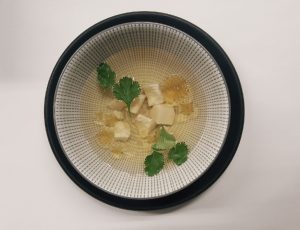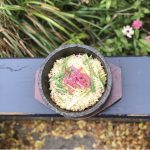Stay Warm like a Korean Buddhist
On one hand, I’m not a classically trained chef. On the other hand, being nerdy comes pretty naturally for me, so I get inspired and research a lot. That the research requires lots of eating, exploring and reading just makes it that much more of a joy.
One of the major inspirations for Miss Kim’s menu is Korean Buddhist cuisine. There are so many tenets of Korean Buddhist cuisine that speak to me, like creating as little waste as possible, or that you should cook with so much love and care, as a parent cooks for a child. Being lucky enough to have a mom who cooked everything from scratch even after working 14 hour days, I really feel that I know what food made with love and care tastes like.
I am always delighted to find a common thread in historic dishes, which I also study, and today’s Buddhist dishes. Sansho pepper was more prevalent than black peppercorn in historic cuisine, for instance, and now you see almost exclusively in Buddhist cuisine.
Another tenet is that you cook with very local, seasonal ingredients. That one is a really great one. Cooking with local ingredients in-season is a hallmark for any traditional cuisine, right? And it really is a foundation Miss Kim is built on. I research traditional Korean dishes, then I ask myself what these dishes would look like if Michigan was a region in Korea. I go out to the Kerrytown Farmers’ Market every week and pick up vegetables in season. Braving the weather to see my favorite farmers and chatting with them, and picking up beautiful vegetables in season, even in the middle of winter, is one of very best parts of my job. This tenet makes me feel confident that if my grandmother or a great Korean Buddhist nun had lived in Michigan they wouldn’t hesitate to use beets from Ann Arbor Seed Company or Goetz Farm, even though beets are not native to Korea. It is native to where we live.
Living in Michigan through long winter months also makes me appreciate cooking with a bit of limitation. Not only is Korean Buddhist cuisine vegan (completely free of any ingredients produced by animals), it also prohibits the use of most of vegetables in the allium family, such as garlic, spring onion, garlic chives, wild chives, and asafoetida (a sort of herb similar to leeks in aroma), along with onions. These vegetables are thought to induce too much passion and are therefore not suitable for meditation. This one is a hard for me, as I love all those pungent things, but putting up such boundaries can make you think outside of the box and find unusual ways to make things delicious—and Korean Buddhist cuisine is famously delicious.
One of the Buddhist dishes that really shines in spite of these limitations is also one of the simplest to make: Silken Tofu and Herbs in Vegetable Broth. The depth of flavor for such a simple dish is surprising, especially if you have labored many hours making vegetable broth. It is soothing and complex and warm, bursting with freshness from the herbs and aromatic oil. This recipe is based on Wookwan Sunim’s recipe, one of the most well known Buddhist nun-chefs in Korea.

Buddhist Silken Tofu Soup
Make the vegetable stock:
1 gallon water
5 pieces dried shiitake mushrooms
1 cup diced Korean moo radish or daikon radish
6-inch piece dashima or kombu seaweed
Put water, mushrooms and radishes into a pot and bring to boil.
Simmer for about 30 minutes.
Add dashima seaweed into the pot and simmer for another 10 minutes.
Strain and cool the vegetable stock until needed.
Make soup broth:
3 cups vegetable stock
1 ¼ cups silken tofu
½ teaspoon sea salt
1 teaspoon soy sauce
Put the vegetable stock in a pot and bring to boil. Add sea salt and soy sauce.
Using a spoon, add silken tofu to the pot. The smaller the tofu pieces, the better.
Bring the broth back to boil, then take it off the stove.
Put in a soup bowl.
Garnish and enjoy!
1 oz chopped fresh cilantro
1 tablespoon perilla oil (can be found at Korean grocery stores, may substitute sesame or other aromatic oils)
I have to confess that I often play fast and loose with this recipe, throwing in whichever vegetable ends and peels I have around, including some of the forbidden vegetables like leeks and green onions. I figured it helps to eliminate waste. Feel free to do the same—it will be delicious, warm and soothing, and may even be passion inducing. Isn’t that what we all really need for the Michigan winter?
Ji Hye Kim
Chef and Managing Partner
Miss Kim Korean Restaurant




Zingerman’s Art for Sale